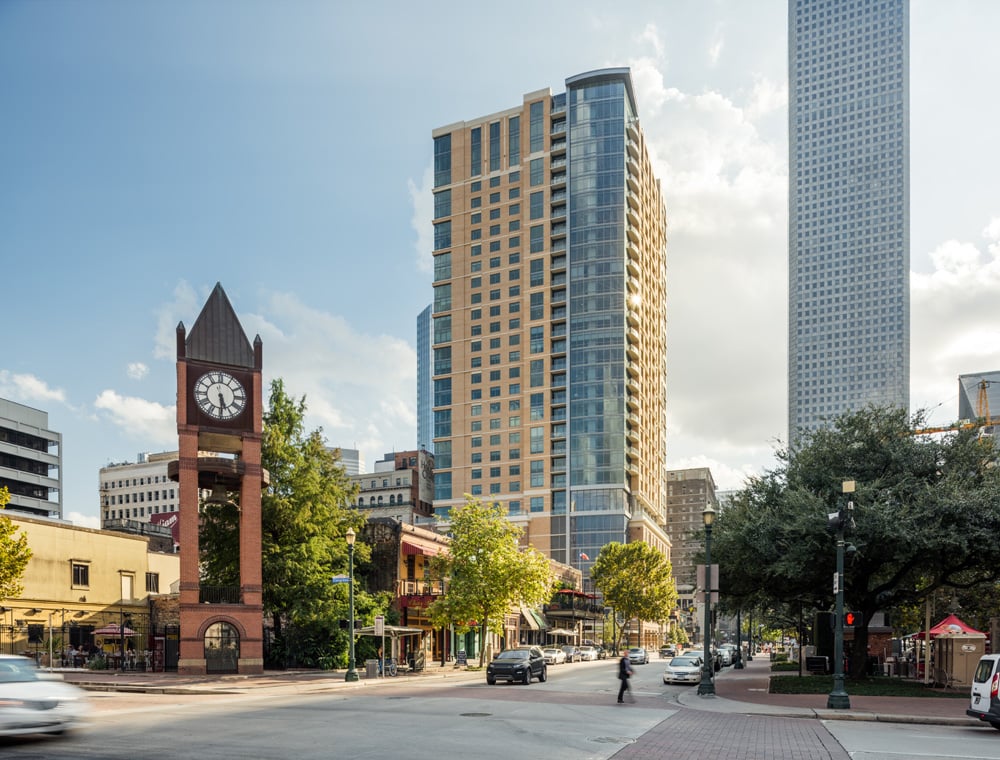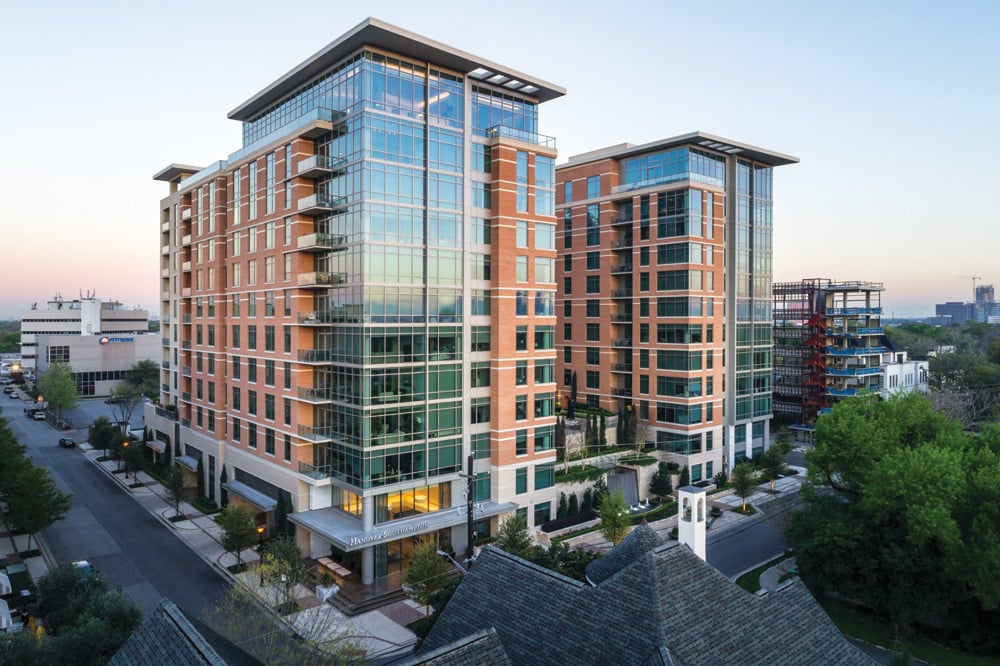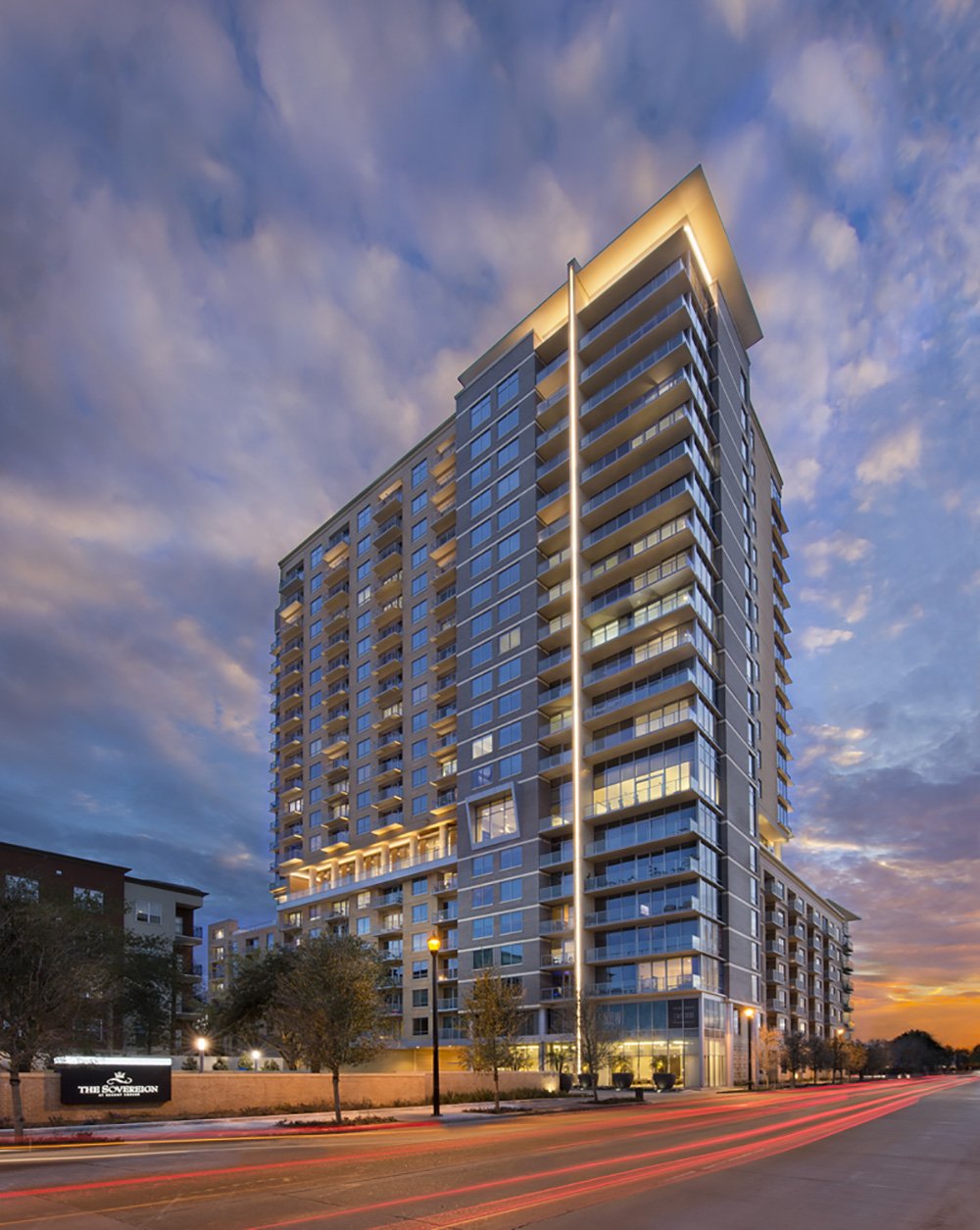
December 1, 2017
Urban Density, Walkability, and Live-Work Lifestyle: Developing Livable Cities
A Q&A with Ziegler Cooper Architects on the shift in America’s urban density patterns due to changing lifestyles and workplace demographics.
For the past three years Metropolis’s director of design innovation Susan S. Szenasy has been leading a series of discussions with industry leaders on important issues surrounding human-centered design. On April 20th, in Houston, she visited the studio of Ziegler Cooper Architects, where she discussed the city’s transformation to a vibrant urban center. The panel included architects, designers, and city planners and they examined America’s shift in urban density patterns due to changing lifestyles and workplace demographics, as well as the creative challenges and opportunities of the mixed-use model. What follows is an edited transcript of the conversation, prepared by M. Nacamulli.
Susan S. Szenasy director of design innovation, Metropolis Magazine (SSS): On the urban scale, everything interconnects. You can’t mention work without life, or hospitality without work. I’d like us to unravel the idea of work lifestyles and how Houston Downtown identifies with it.
Lonnie Hoogeboom, director of planning and design, Downtown District (LH): Houston is changing rapidly, nowhere more evidently than in our central core, Downtown. We are engaged in a 20-year planning process, positioning Downtown in a perpetual revolution of improvement. Downtown is experiencing an investment transformation, with an enormous increase in private investment over the past five years.
The issue is thinking beyond the current cycle and the area’s challenging past, to where we want to be in the future. In Downtown, which has historically been a business district, we are developing residential and hospitality properties. Meanwhile, the need for more public space to connect neighborhoods, people, and nature has been a great focus of the community.
We’re working with our adjacent management districts and neighborhoods to improve and revitalize Downtown. As a group, we are trying to understand how to address conditions and connections between neighborhoods. Houston’s enormous highway infrastructural project drove much of our planning process, compelling neighborhoods to collaborate out of necessity. We can’t continue to think in a silo way, because we have to know what’s coming and how to build our future opportunities.
SSS: Jonathan, as a developer, where do you see your future and the city’s future melding together?
Jon Brinsden, chief executive officer, Midway (JB): A lot of our recent investment has been inside what we call the global gateway core of Houston. Our company’s purpose is to build enduring investments and remarkable places to enrich people’s lives.
SSS: Scott, as an expert on the front line of building and renovating, what’s your assessment of the urbanization movement in Houston?
Scott Ziegler, AIA, senior principal, principal-in-charge, Urban Residential/Mixed-Use Studio, Ziegler Cooper (SZ): I was dumbfounded on my first trip to Downtown Houston in the mid-1970’s. It was absolutely dead after work hours – there were 150,000 people working in Downtown and only 500 residents. Since then, shifts in construction costs affected its transformation, but what fundamentally changed it was the generation of millennials that rejected the suburbs in favor of a 24/7 lifestyle. This population of young people coming back to the city is the intellectual capital driving corporations, and this is the primary group seeking an urban lifestyle.

SSS: While age divides millennials from baby boomers, there are certain areas of interest that connect us, like the environment, community living, and connectivity. Dawna, can you talk to us about the urban residential mixed-use spaces that you’re working on?
Dawna Houchin, associate principal, senior designer, Urban Residential/Mixed-Use Studio, Ziegler Cooper (DH): We are helping developers determine the social demographic of their target market. We’ve found that there is a trend of three demographic markets that are interested in the projects: the millennials, the laptop and latte (25-40-year-old professionals), and the empty-nesters. Once we sit down with the client and determine the market, we can come up with an appropriate program of amenity spaces. We consider universal amenities that appeal across generations, as well as spaces that foster self-sustained community within the building.
SSS: You have a demographic that wants to live an urban lifestyle with connections to culture and for whom socializing happens in the public realm. How does this affect the amenities you offer?
DH: We’re trying to create multifunctional spaces with many different touch points. For millennials, fitness is the priority. Empty-nesters want more spaces to entertain.
SSS: Manuel Navarro, you’re in charge of something that is constantly shifting and moving.
Manuel Navarro, IIDA, associate principal, design Director, Workplace Interiors Studio, Ziegler Cooper (MN): Building owners are competing for tenants in an amenity arms race. It’s about choice in the workplaces. Corporations and building owners are taking on opportunities at an increasing rate, reinventing themselves and repositioning themselves on the market.
SSS: What workplace scales are you working on?
MN:Lease deals are shrinking in size, probably as a result of landlords providing extra amenities that tenants no longer need to dedicate space to. The influence of co-working is also helping to fill the need for low-risk, short-term lease deals. Younger companies can grow with a space, adding to it as necessary. We’re getting a lot more density in offices: Less me space, more we space.
SSS: ‘Less me and more we’ is exactly what this world is about, but it needs balance, too. How do acoustics, proximity, and other factors contribute to effective work?
MN: While every industry has different needs, a certain ratio generally works. For every 100 people, you need seven to ten one-person focus rooms, in addition to flexible spaces. In an open office space, you have the ability to collaborate and interact, as well as visual cues to create focused space. It’s about finding a balance on how to cater to the needs of mixed-generation spaces.
SSS: We used to have ergonomic chairs keeping us trapped for eight hours in front of our computers. Now there is a desire for wellness and health in the workplace.
MN: Embracing wellness is a cultural shift within a company. One client, for instance, has a staff member blow a whistle twice a day, signaling to his colleagues to exercise. I’ve also done an active conference room, with a standing height round table and an array of spin bikes, so you can hold meetings while being active.
SSS: Jonathan, how do you do approach integration in your projects?
JB: From a macro standpoint, we’ve made the conscious decision to be in the experience business, positioning ourselves to help people accomplish their goals. Most of the work we do is mixed-use in nature, with office, retail, multi-family, and amenities all within a building.
SSS: Another amenity of urban life is walking and interacting outside. How are connections to street space and other people being encouraged?
LH: One of the great things about an urban center is that you have opportunities to engage with other people on the street. In Downtown Houston, we need to leverage the tunnels with individual developers so that they can be cross-programmed. We need to reactivate and reprogram every possible pocket of space and building frontage. How can lobby walls open up to the street to embrace opportunities for a public dimension?
Another real challenge in Downtown Houston is the result of a historic manufacturing process that extended basements of corporate towers to the curb, limiting the possibility to even plant a tree. As a result, Downtown has hard edges. Finding ways of undoing that is challenging.
JB: We’re making tremendous strides in terms of reactivating the public realm. Today, with massive growth in the residential, hospitality, green space, and transportation realms, we’ve created an active street environment.
SZ: We’re at an early stage, but already seeing the number of Downtown residents increase substantially. We activate the streetscape of our new buildings with retail space for food & entertainment.
SSS: Houston’s medical community is hugely powerful. There is a lot of action aimed at program development and health consciousness. Discovery, especially in the field of medical research, is cooperative, collaborative, and progressive, bringing opportunities for businesses and people.
JB: Green spaces have been one of the big transformational elements for the city, and I don’t think that successful urbanization and densification happens without them.
LH: The Buffalo Park project, realized just a couple of years ago, was seeded in 1986 in a mayor’s vision, which speaks to the power of the planning process. The park has become a destination space for people who want to take walks, go on bike rides, go to the cistern, or go kayaking. With the formation of the Buffalo Bayou, we reclaimed the area not just as infrastructural space, but also as public space.
What’s happening on the building scale with opportunities for multiple layers of amenities also has to happen on the urban scale in finding opportunities to connect green spaces. Our green spaces really are our public living rooms.
JB: For years we turned our back to the bayous, until we realized that they are uniquely Houston. We needed to embrace and leverage them. From a public infrastructure investment standpoint, the return on the investment that’s been put into bayou greenways is phenomenal. It is connecting neighborhoods in transformational ways.
SSS: Texas is very interested in technologies. Nowadays, with distance shopping and so much convenience, there must be an opportunity for human development. With so many things taken care of for us, we can do other activities to keep our brains alive and bodies alive and healthy.
JB: We’re all looking for efficiency. We’re busier, and people are very conscious about how they use and manage their time. People try to capture time they can use to for rewarding experiences and leverage the time they do have to its fullest.

JB: Compared to previous generations, people’s lives today are one big intertwined network. It’s liberating in many ways, but also makes managing your life more challenging.
SSS: We are at the beginning of this amazing urbanization project, in which every settlement is trying to figure out how to bring people together. What are the biggest challenges and priorities?
SZ: With increases in the cost of construction, what started out as densification models for architecture have gotten more complex. Our challenge is to incorporate the human element to connect to the fabric of the city. All of our urban projects now consist of mixed-use elements to enrich the human experience.
SSS: Also to connect them to each other, especially with communities sharing amenities and spaces within buildings.
JB: Because urbanization generally increases prices, I worry, from an education and affordable-housing standpoint, about creating an environment that is available to a broad subset of our community and doesn’t displace people.
SSS: That equity issue is constant and can’t be ignored.
DH: These projects are currently for the millennials, the empty-nesters, and the laptops and lattes. Currently, those are not necessarily the trendsetters, but the early adopters. Once there’s enough density within this group, we can attract young families into this building typology as well.
LH: Global polarization is starting to reflect on local communities in ways that we don’t quite understand yet. We need to make spaces that can bridge that polarization. While there is a tendency to isolate in the world today, we are also seeing strong activism to restore community and help one another. Compassionate, smart urbanism provides equity, choices, and opportunity.
SZ: The real issue right now is improving the level of our education system and providing good neighborhood school options in the urban core.
SSS: If you’re serious about all kinds of people inhabiting an urban core, then you have to make sure that the schools are there.
JB: Our foundation does a lot of work with underprivileged schools, and research shows is the single biggest factor in changing the quality of a school is parent involvement. If we can get families to stay and become involved, schools get better.
AUDIENCE MEMBER: From a development standpoint, what do you think of the extension of the rail system?
JB: The rail, whether in place or developing, can affect land prices to actually prohibit development for some time. And we have to remember that it’s also about how far residents are willing to walk to the station. So, as you start to draw those quarter mile nodes around stations, the landscape transforms.
LH: In some neighborhoods, Metro is piloting what they’re calling a community connector, which provides a local internal neighborhood shuttle service, allowing people that are dependent on transit to have in-neighborhood services provided for them.
JB: Investing in buses is far more cost-efficient and completely flexible because you don’t have the in-place infrastructure cost. But there is the notion that riding on a rail is sexier than riding on a bus. We need to make the bus experience so positive that people overcome that barrier.
SSS: You’re talking about reassessing so many systems that are in place. Efficiency is not just making them work, but making them profitable, usable, and hospitable. We’ll be looking forward to coming back and seeing where all of this development leads.

Panelists:
Jonathan Brinsden, chief executive officer, Midway
Lonnie Hoogeboom, director of planning and design, Downtown District
Dawna Houchin, associate principal, senior designer, Urban Residential/Mixed-Use Studio, Ziegler Cooper
Manuel Navarro, IIDA, associate principal, design director, Workplace Interiors Studio, Ziegler Cooper
Scott Ziegler, AIA, senior principal, principal-in-charge, Urban Residential/Mixed-Use Studio, Ziegler Cooper
Moderator: Susan S. Szenasy, director of design innovation, Metropolis magazine
The Metropolis Think Tank series is presented in partnership with Corian® Design, DXV/GROHE, Staples Business Advantage, Sunbrella Contract Fabrics, and XtremeInterior Architectural Solutions.





